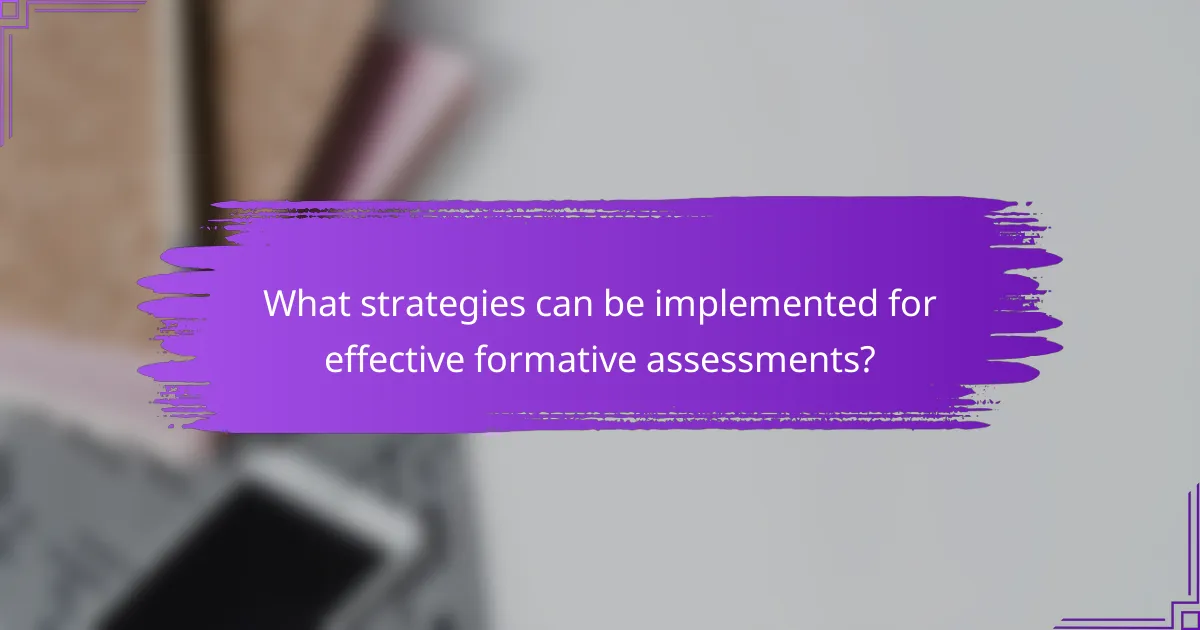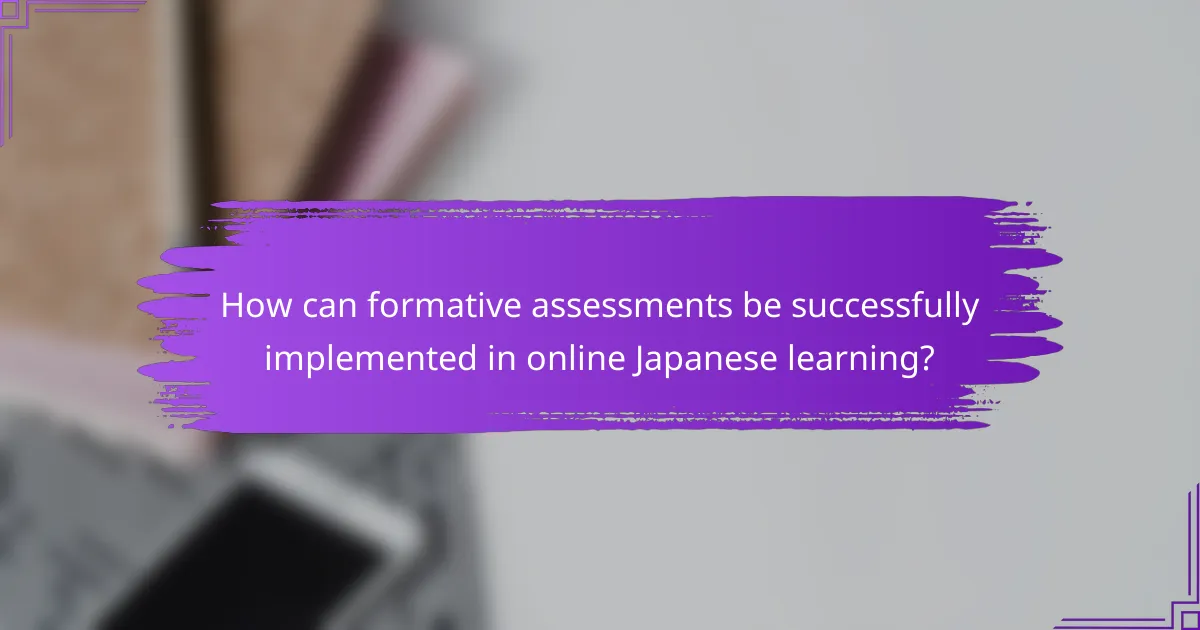
What are Formative Assessments in Online Japanese Learning?
Formative assessments in online Japanese learning are tools used to monitor student progress and understanding. They provide ongoing feedback to both learners and instructors. This type of assessment helps identify areas needing improvement. Examples include quizzes, discussion posts, and interactive exercises. Formative assessments are integral to adapting teaching strategies. They enhance learner engagement and motivation. Research shows that regular feedback can improve language acquisition. These assessments support a personalized learning experience in online environments.
How do formative assessments differ from summative assessments?
Formative assessments are ongoing evaluations used to monitor student learning. They provide feedback during the learning process. This feedback helps teachers adjust their instruction. Examples include quizzes, discussions, and observations. Summative assessments, on the other hand, evaluate student learning at the end of an instructional period. They measure what students have learned. Examples include final exams and standardized tests. The key difference lies in their timing and purpose. Formative assessments aim to improve learning, while summative assessments aim to measure learning outcomes.
What are the key characteristics of formative assessments?
Formative assessments are ongoing evaluations used to monitor student learning. They provide immediate feedback to both students and educators. These assessments help identify strengths and weaknesses in understanding. They guide instructional adjustments to improve learning outcomes. Formative assessments can take various forms, such as quizzes, discussions, and peer reviews. They encourage student engagement and self-reflection. Data collected from these assessments informs future teaching strategies. Research indicates that formative assessments significantly enhance student performance and retention.
Why are formative assessments important in language learning?
Formative assessments are crucial in language learning as they provide ongoing feedback to both learners and instructors. They help identify students’ strengths and weaknesses in real-time. This immediate feedback allows for timely interventions and adjustments in teaching strategies. Research indicates that formative assessments enhance learner engagement and motivation. They encourage self-reflection and ownership of the learning process. Studies have shown that students who receive regular formative feedback perform better in language acquisition. Overall, formative assessments support a more personalized and effective learning experience in language education.
What role do formative assessments play in online Japanese learning?
Formative assessments play a crucial role in online Japanese learning by providing ongoing feedback to both learners and instructors. These assessments help identify learners’ strengths and weaknesses in language acquisition. They enable instructors to tailor their teaching strategies based on student performance. Formative assessments can take various forms, including quizzes, discussions, and peer reviews. This continuous evaluation fosters a deeper understanding of the language. Research shows that formative assessments enhance motivation and engagement among learners. They also promote self-regulated learning, as students can track their progress over time. Overall, formative assessments are essential for effective online Japanese learning.
How can formative assessments enhance student engagement?
Formative assessments enhance student engagement by providing ongoing feedback that supports learning. This type of assessment allows students to understand their strengths and weaknesses. It encourages active participation in the learning process. Students become more invested when they see their progress. Research shows that formative assessments improve motivation and academic performance. A study by Black and Wiliam (1998) found that formative assessments can lead to significant gains in student achievement. By making learning more interactive, formative assessments foster a collaborative learning environment. This interaction keeps students engaged and encourages peer learning.
What impact do formative assessments have on language acquisition?
Formative assessments significantly enhance language acquisition. They provide ongoing feedback to learners, allowing for adjustments in learning strategies. This feedback helps identify areas of difficulty, promoting targeted practice. Research shows that formative assessments can increase student motivation and engagement. A study by Black and Wiliam (1998) found that effective formative assessment can lead to substantial learning gains. Additionally, formative assessments foster a deeper understanding of language concepts. They encourage self-reflection and self-assessment among learners. This active involvement in the learning process further supports language development. Overall, formative assessments play a crucial role in facilitating effective language acquisition.
What are the benefits of using formative assessments in online Japanese courses?
Formative assessments in online Japanese courses enhance learning by providing ongoing feedback. They help students identify strengths and weaknesses in their language skills. This feedback allows for timely adjustments in learning strategies. Formative assessments also promote active engagement in the learning process. They encourage self-reflection and self-assessment among students. Research shows that regular feedback can lead to improved academic performance. A study by Hattie and Timperley (2007) indicates that feedback is one of the most powerful influences on learning outcomes. Overall, formative assessments support personalized learning experiences in online Japanese education.
How do formative assessments support individualized learning?
Formative assessments support individualized learning by providing ongoing feedback tailored to each student’s needs. These assessments identify specific strengths and weaknesses in a learner’s understanding. They allow educators to adjust instruction based on real-time data. For example, quizzes and reflections can highlight areas needing improvement. This targeted approach fosters a personalized learning experience. Research shows that students who receive tailored feedback perform better academically. A study by Black and Wiliam (1998) indicates that formative assessment can significantly enhance student achievement. Thus, formative assessments are essential for customizing educational strategies.
What advantages do formative assessments offer for instructors?
Formative assessments provide instructors with immediate feedback on student understanding. This feedback allows instructors to adjust their teaching strategies in real-time. Instructors can identify areas where students struggle. This helps in tailoring instruction to meet student needs. Formative assessments also foster a supportive learning environment. They encourage student engagement and participation. Research shows that timely feedback enhances student performance. Instructors can track progress over time with formative assessments. This data informs future lesson planning and curriculum development.

What strategies can be implemented for effective formative assessments?
Effective formative assessments can be implemented through various strategies. One strategy is to use regular quizzes to gauge student understanding. These quizzes can provide immediate feedback on learning progress. Another strategy is to incorporate peer assessments, allowing students to evaluate each other’s work. This encourages collaboration and critical thinking. Additionally, utilizing exit tickets can help teachers understand what students have learned at the end of a lesson. Formative discussions in small groups can also enhance understanding and provide insights into student perspectives. Lastly, integrating technology tools like online surveys can streamline feedback collection. Research shows that these strategies improve student engagement and learning outcomes in educational settings.
How can technology be leveraged for formative assessments?
Technology can be leveraged for formative assessments through various digital tools and platforms. These tools include online quizzes, interactive simulations, and real-time feedback systems. They allow educators to gather data on student performance instantly. For example, platforms like Kahoot and Google Forms enable quick assessments that can be analyzed immediately. Learning management systems, such as Moodle and Canvas, provide integrated assessment features. They facilitate tracking student progress over time. Additionally, analytics from these technologies can inform instructional adjustments. Research shows that technology-enhanced formative assessments improve student engagement and learning outcomes.
What tools and platforms are best suited for online formative assessments?
Google Forms is an effective tool for online formative assessments. It allows educators to create surveys and quizzes easily. Teachers can analyze responses in real-time. Another suitable platform is Kahoot, which gamifies assessments to engage students. Kahoot offers interactive quizzes that enhance learning. Quizlet is also popular for creating flashcards and quizzes. It supports various study modes and promotes active recall. Edmodo provides a collaborative space for assessments and feedback. It enables communication between educators and students. Lastly, Nearpod integrates interactive lessons with formative assessments. It allows teachers to gauge student understanding instantly. These tools enhance the online learning experience in Japanese education.
How can interactive activities be integrated into formative assessments?
Interactive activities can be integrated into formative assessments by incorporating tools like quizzes, polls, and discussion forums. These tools engage learners and provide immediate feedback. For example, using online quizzes allows students to assess their understanding in real-time. Polls can gauge student opinions and comprehension during lessons. Discussion forums encourage collaboration and peer feedback, enhancing learning outcomes. Research shows that active participation increases retention rates, making assessments more effective. A study by Freeman et al. (2014) found that interactive learning significantly boosts student performance. This evidence supports the integration of interactive activities into formative assessments for better educational results.
What are some best practices for designing formative assessments?
Best practices for designing formative assessments include aligning assessments with learning objectives. This ensures that assessments measure the intended skills and knowledge. Incorporating a variety of assessment methods enhances engagement and caters to different learning styles. Providing timely and specific feedback helps learners understand their progress and areas for improvement. Utilizing peer assessments encourages collaboration and critical thinking among students. Regularly reviewing and adjusting assessments based on learner performance promotes continuous improvement. Research indicates that formative assessments can significantly enhance learning outcomes when implemented effectively. For instance, a study by Black and Wiliam (1998) found that formative assessments improve student achievement in various educational settings.
How can clear learning objectives improve formative assessments?
Clear learning objectives enhance formative assessments by providing specific goals for both instructors and students. These objectives guide the assessment design, ensuring alignment with desired outcomes. When objectives are clear, students understand what is expected of them. This clarity helps them focus their efforts on relevant skills and knowledge. Consequently, formative assessments become more targeted and effective. Research indicates that well-defined objectives lead to improved student performance. For instance, a study by Hattie and Timperley (2007) found that clear learning goals significantly boost student achievement. This evidence supports the idea that clarity in objectives directly influences the quality of formative assessments.
What types of feedback are most effective in formative assessments?
Specific, timely, and actionable feedback is most effective in formative assessments. This type of feedback helps learners understand their strengths and areas for improvement. Specific feedback targets particular skills or knowledge gaps. Timely feedback ensures that learners receive information while the content is still fresh in their minds. Actionable feedback provides clear steps for improvement. Research shows that feedback focused on process rather than person enhances learning. Additionally, peer feedback can foster collaborative learning and deeper engagement. Effective feedback is crucial for guiding learners and improving their performance in formative assessments.

How can formative assessments be successfully implemented in online Japanese learning?
Formative assessments can be successfully implemented in online Japanese learning by integrating regular feedback mechanisms. These assessments should be designed to evaluate students’ understanding continuously. Techniques such as quizzes, peer reviews, and interactive discussions can be utilized. Utilizing online tools like Google Forms or Kahoot! facilitates instant feedback. Incorporating self-assessment opportunities encourages learners to reflect on their progress. Additionally, aligning assessments with learning objectives ensures relevance. Research indicates that formative assessments enhance student engagement and retention. For instance, a study by Black and Wiliam (1998) found that effective formative assessment practices significantly improve learning outcomes.
What steps should educators take to introduce formative assessments?
Educators should begin by defining formative assessments and their purpose in learning. They should then identify specific learning objectives that align with the assessments. Next, educators should select appropriate formative assessment methods, such as quizzes, discussions, or peer reviews. After that, they should design assessments that are clear and accessible to all students. Educators must communicate the purpose and benefits of formative assessments to students. They should implement the assessments regularly to monitor progress. Finally, educators need to analyze the results and provide timely feedback to students. This structured approach enhances student engagement and learning outcomes.
How can instructors ensure alignment with course goals?
Instructors can ensure alignment with course goals by clearly defining those goals at the outset. This involves articulating specific learning outcomes for students. Instructors should also design assessments that directly measure these outcomes. Regularly reviewing and adjusting course content to reflect these goals is essential. Additionally, providing feedback to students on their progress supports alignment. Utilizing formative assessments allows instructors to gauge understanding throughout the course. Research indicates that clearly defined goals enhance student performance (Hattie, 2009). By following these strategies, instructors can maintain alignment with course objectives effectively.
What challenges might arise during implementation, and how can they be addressed?
Challenges during implementation of formative assessments in online Japanese learning include technical issues, lack of engagement, and insufficient training. Technical issues may arise from unreliable internet connections or platform malfunctions. To address this, institutions should ensure robust technical support and provide alternative assessment methods. Lack of engagement can occur if students do not find the assessments relevant or motivating. This can be mitigated by designing assessments that are interactive and culturally relevant. Insufficient training for instructors on how to effectively use formative assessments can hinder implementation. Providing comprehensive training programs and resources will help educators utilize these assessments effectively. These strategies can enhance the overall learning experience and ensure successful implementation.
What are some common pitfalls to avoid in formative assessments?
Common pitfalls to avoid in formative assessments include unclear objectives. When objectives are not specific, students may not understand what is expected. Another pitfall is inadequate feedback. Feedback should be timely and constructive to be effective. Over-reliance on a single assessment method can also be problematic. Diverse methods provide a more comprehensive understanding of student progress. Additionally, failing to involve students in the assessment process can lead to disengagement. Engaging students fosters ownership of their learning. Lastly, neglecting to adjust instruction based on assessment results undermines the purpose of formative assessments. Adjustments are essential for addressing student needs and improving learning outcomes.
How can over-reliance on technology hinder the assessment process?
Over-reliance on technology can hinder the assessment process by limiting critical thinking skills. When learners depend too much on automated systems, they may not engage deeply with the material. This can lead to superficial understanding rather than mastery of concepts. Additionally, technology can introduce biases in grading, as algorithms may not account for individual learning styles. Research shows that assessments lacking human oversight can miss nuances in student performance. Furthermore, excessive reliance on technology can create technical issues, disrupting the assessment process. These disruptions can lead to inconsistent evaluation results.
What misconceptions about formative assessments should be clarified?
Formative assessments are often misunderstood as mere quizzes or tests. Many believe they only serve to grade students, but their primary purpose is to inform instruction. Formative assessments provide ongoing feedback to both learners and educators. This feedback helps identify strengths and areas for improvement. Another misconception is that formative assessments are time-consuming. In reality, they can be quick and integrated into daily activities. Additionally, some think formative assessments are only for teachers. However, they also empower students to take ownership of their learning. Research shows that effective formative assessments can lead to improved student outcomes. For instance, a study by Black and Wiliam (1998) found that formative assessment can significantly enhance learning when used correctly.
What practical tips can enhance the effectiveness of formative assessments in online Japanese learning?
Incorporating interactive tools can enhance formative assessments in online Japanese learning. Tools like quizzes and polls engage students actively. Regular feedback is crucial; it helps learners understand their progress. Setting clear objectives for each assessment guides students effectively. Using varied assessment formats caters to different learning styles. Incorporating peer assessments fosters collaboration and critical thinking. Regularly reviewing assessment data allows for timely adjustments in teaching methods. These strategies collectively improve the learning experience and outcomes in online Japanese education.
The main entity of the article is formative assessments in online Japanese learning. This article provides an in-depth examination of the significance of formative assessments, highlighting their role in monitoring student progress, enhancing engagement, and facilitating personalized learning experiences. Key characteristics, differences from summative assessments, and effective strategies for implementation are discussed, along with the benefits for both students and instructors. Additionally, the article addresses common challenges and misconceptions, offering practical tips for optimizing formative assessments in online language education.